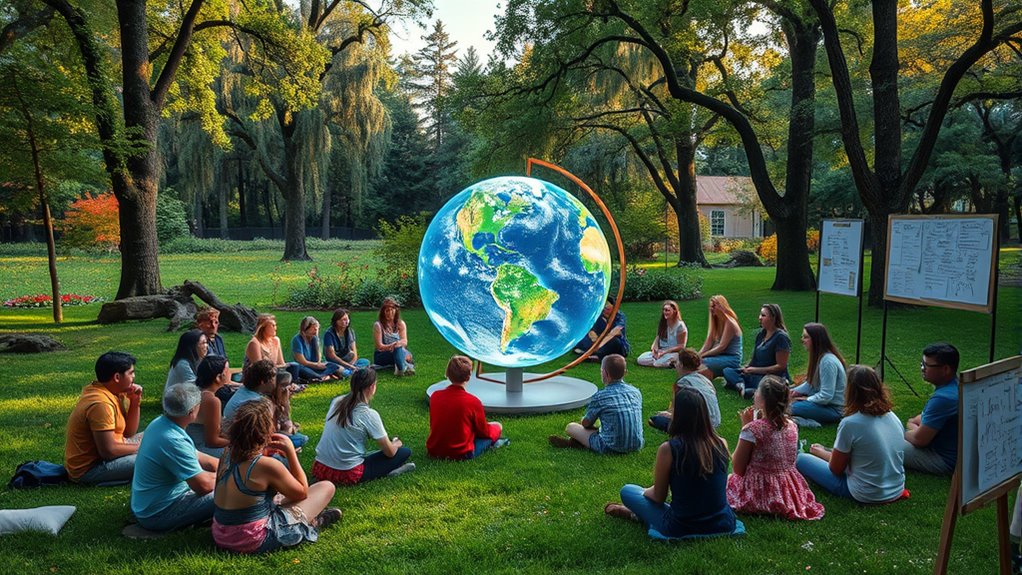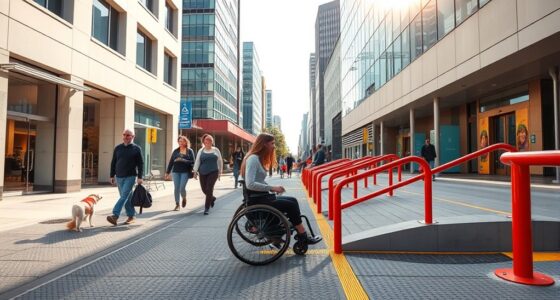Moving from traditional human-centered design to a planet-centric approach broadens your empathy beyond individual users to encompass ecosystems and future generations. You’ll learn to contemplate environmental impacts, use sustainable materials, and integrate ecological metrics into your process. This shift helps create solutions that respect biodiversity, reduce resource depletion, and promote long-term ecological balance. If you continue exploring, you’ll discover practical strategies to embed these principles into your design practice and build a more sustainable future.
Key Takeaways
- Broaden empathy from individual user needs to include ecosystem health and biodiversity for sustainable design solutions.
- Incorporate environmental metrics and lifecycle assessments to measure and reduce ecological impacts.
- Foster cross-disciplinary collaboration to integrate diverse perspectives on ecological and social sustainability.
- Recognize interconnectedness of human and natural systems, emphasizing long-term planetary well-being.
- Embed sustainable practices early, using biomimicry and circular economy principles to promote responsible innovation.
Understanding the Limitations of Traditional Human-Centered Design

While human-centered design (HCD) has driven many innovative solutions, it often falls short in addressing broader environmental and societal impacts. You focus on optimizing user experience and meeting user needs, but this approach can overlook how those needs affect the planet. HCD tends to prioritize individual preferences without considering long-term ecological consequences or community well-being. As a result, products may be user-friendly but contribute to issues like resource depletion or waste. You might create intuitive interfaces and seamless interactions, yet miss opportunities to design with sustainability in mind. This narrow focus limits the potential for truly responsible innovation. To create meaningful change, you need to expand your perspective beyond just users and their immediate needs. Incorporating a sustainable design mindset can help bridge this gap and foster more environmentally conscious solutions.
The Need for a Broader Perspective: Why Planet-Centric Thinking Matters

A single focus on user experience isn’t enough to guarantee sustainable and responsible innovation. To truly make a positive impact, you need a broader perspective that considers the health of the entire planet. Planet-centric thinking emphasizes ecosystem resilience and biodiversity preservation, recognizing that human well-being depends on a thriving natural environment. When you expand your view beyond individual users, you start addressing systemic issues that threaten ecosystems and biodiversity. This approach encourages you to design solutions that support long-term ecological balance, ensuring resources remain available for future generations. By adopting planet-centric thinking, you move from isolated user needs to a holistic understanding of our interconnected world, fostering innovations that benefit both people and the planet. Incorporating principles like sustainable design can further enhance your efforts toward environmental responsibility.
Redefining Empathy: From Individuals to Ecosystems

To truly embrace planet-centric design, you must expand your sense of empathy beyond individual users to encompass entire ecosystems. This shift requires heightened emotional intelligence to sense and interpret complex environmental signals and cultural awareness to understand diverse perspectives and values across communities. Recognize that ecosystems are interconnected, and actions affecting one part ripple through the whole. Cultivating empathy at this scale involves seeing beyond immediate needs, appreciating the long-term health and balance of natural systems. By developing this broader emotional intelligence and cultural awareness, you move from a human-centered mindset to one that considers the well-being of all living systems. This holistic approach enables you to design solutions that respect and restore the intricate web of life supporting the planet.
Integrating Environmental Considerations Into the Design Process

To truly adopt a planet-centric approach, you need to evaluate how your designs impact the environment. Consider using eco-friendly materials and designing for lifecycle sustainability to minimize waste and resource use. By integrating these environmental considerations early, you can create solutions that are both innovative and responsible, ensuring your designs support sustainable forestry and reduce emissions.
Assessing Environmental Impact
How can you effectively appraise the environmental impact of your decisions early in the process? Start by calculating the project’s carbon footprint, which measures the total greenhouse gases produced. This helps you identify stages where emissions are highest and prioritize reductions. Incorporate resource conservation strategies by assessing how much material and energy each option consumes. Use life cycle assessments to understand impacts from raw material extraction to disposal. Engage stakeholders to gather diverse insights on sustainability. Keep environmental metrics integrated into your design criteria, enabling you to compare alternatives objectively. Regularly review these assessments to stay aligned with eco-friendly goals. By systematically evaluating these factors upfront, you make smarter choices that minimize environmental harm and promote sustainable development from the outset.
Incorporating Eco-friendly Materials
Ever considered how selecting eco-friendly materials can reshape your design’s environmental footprint? By prioritizing eco-conscious sourcing, you guarantee your materials come from sustainable, responsible origins. Incorporating biodegradable packaging reduces waste and minimizes pollution, allowing products to break down naturally without harming ecosystems. Using biodegradable options signals your commitment to environmental health and encourages consumers to make greener choices. When you choose eco-friendly materials, you not only lower the impact of production and disposal but also set a standard for sustainability in your industry. This shift requires researching suppliers who prioritize sustainability and integrating these materials early in your design process. Small decisions, like opting for biodegradable packaging, can notably enhance your project’s overall eco footprint. Additionally, understanding wood stove safety standards and regulations can help ensure your project aligns with environmental and safety best practices, reducing potential hazards and promoting responsible design.
Designing for Lifecycle Sustainability
Have you considered how integrating environmental considerations early in your design process can extend a product’s sustainability throughout its lifecycle? By embracing biomimicry innovations, you can develop solutions that mimic nature’s efficiency and resilience, reducing environmental impact. Incorporate principles of the circular economy to design for reuse, recycling, and minimal waste. This approach encourages you to think beyond the initial manufacturing phase, focusing on durability and end-of-life management. Lifecycle sustainability means creating products that serve their purpose without depleting resources or creating excess waste. Additionally, accessible sustainable solutions can help more individuals and businesses adopt eco-friendly practices. By embedding these strategies into your design process, you help shift toward a more sustainable future, where materials are continuously cycled and environmental impacts are minimized. It’s about designing not just for today, but for a healthier planet tomorrow.
Case Studies: Successful Transition to Planet-Centric Approaches

Shifting to planet-centric design has yielded impressive results for organizations that prioritize environmental sustainability and stakeholder engagement. One example is a global apparel company that integrated cultural sensitivity into its supply chain, ensuring local communities’ values shaped product development. This approach enhanced user engagement by making products more relevant and respectful of diverse cultures, resulting in increased brand loyalty. Another case involved a tech firm redesigning its product lifecycle to minimize environmental impact, engaging users in sustainability efforts through transparent communication. These organizations successfully transitioned by aligning their core values with planetary health, fostering stronger stakeholder relationships. Such examples demonstrate that when you embed cultural sensitivity and actively involve users, the shift to planet-centric design becomes both practical and impactful. Incorporating eco-friendly materials and sustainable practices further strengthens these initiatives, underscoring the importance of environmentally conscious choices in design.
Practical Strategies for Embedding Planetary Awareness in Design Practices

You can start by integrating ecological metrics into your design process to measure environmental impact directly. Fostering cross-disciplinary collaborations helps bring diverse perspectives and innovative solutions. Remember to prioritize long-term impacts to guarantee your designs support sustainable, planet-friendly outcomes. Incorporating eco-friendly options such as recycled materials and sustainable practices can further enhance the environmental benefits of your designs.
Integrate Ecological Metrics
To effectively embed planetary awareness into design practices, integrating ecological metrics provides a practical and measurable approach. Start by evaluating biodiversity metrics to understand how your design impacts local ecosystems and species diversity. This helps identify areas where interventions can support ecological resilience. Additionally, consider calculating the ecological footprint of your project—measuring resource consumption and waste generation throughout its lifecycle. By tracking these metrics, you gain concrete data to inform decision-making, set reduction targets, and demonstrate environmental responsibility. Incorporating ecological metrics into your design process makes sustainability tangible, encouraging continuous improvement. This approach shifts focus from vague intentions to clear, actionable insights, fostering designs that respect planetary boundaries and promote long-term ecological health. Monitoring resource usage and adjusting strategies accordingly further enhances the ecological integrity of your projects.
Foster Cross-Disciplinary Collaborations
Integrating ecological metrics into your design process highlights the need for diverse expertise to address complex environmental challenges. To do this effectively, foster cross-disciplinary collaborations that encourage interdisciplinary communication. Bring together specialists from ecology, engineering, social sciences, and design to share perspectives and insights. This diversity sparks collaborative innovation, helping you develop more holistic and sustainable solutions. Create opportunities for team members to learn from each other’s disciplines, breaking down silos and building mutual understanding. Emphasize shared goals centered on planetary well-being, and establish clear channels for ongoing dialogue. By actively nurturing these collaborations, you’ll develop designs rooted in all-encompassing ecological awareness, ensuring your work contributes meaningfully to planetary health and resilience. Incorporating ecological metrics into your workflow can further enhance the effectiveness of these cross-disciplinary efforts.
Prioritize Long-Term Impacts
Embedding planetary awareness into design practices requires a deliberate focus on long-term impacts that extend beyond immediate needs. You need to contemplate how your decisions affect ecosystems, resources, and communities over decades. Prioritize stakeholder engagement to gather diverse perspectives, ensuring cultural sensitivity guides your approach. By involving local communities and respecting cultural contexts, you create solutions that are sustainable and inclusive. Think beyond quick fixes—assess how your design choices influence future generations and planetary health. Incorporate feedback loops that monitor environmental and social impacts over time. This long-term mindset helps you avoid unintended harm, fostering resilience and adaptability. Ultimately, your goal is to develop designs that support a thriving planet while respecting cultural diversity and stakeholder interests.
Envisioning a Sustainable Future Through Expanded Empathy

Expanding empathy is essential for envisioning a sustainable future, as it allows you to see beyond immediate needs and consider the broader impact of your actions. By understanding diverse cultural narratives, you gain insight into different values and worldviews that shape behaviors and priorities. This awareness helps you navigate ethical dilemmas more thoughtfully, recognizing the complex trade-offs involved in sustainable choices. When you broaden your perspective, you become more attuned to how individual and collective actions influence ecosystems, communities, and future generations. Expanding empathy encourages you to move past self-interest, fostering a deeper commitment to planet-centric design. Additionally, visual communication plays a crucial role in conveying complex ideas and fostering understanding across cultures. Ultimately, it empowers you to create solutions that are not only innovative but also ethically grounded and culturally sensitive, paving the way for a truly sustainable future.
Frequently Asked Questions
How Can Designers Measure Planetary Impact Effectively?
You can measure planetary impact effectively by focusing on sustainable metrics that track resource use, emissions, and waste. To gauge ecosystem impact, analyze how your designs influence biodiversity, water, and soil health. Use tools like life cycle assessments and environmental footprint calculators to gather data. Regularly monitor and compare these metrics to identify areas for improvement, ensuring your designs support long-term sustainability and minimize harm to the planet.
What Challenges Exist in Shifting From Human to Planet-Centric Design?
Imagine redesigning a product with eco ethics in mind, but you face challenges in integrating ecological metrics into your process. Shifting from human to planet-centric design requires rethinking priorities, often clashing with existing business models. You might struggle with measuring planetary impact accurately or convincing stakeholders of the importance of ecological considerations. These challenges stem from the complexity of ecological systems and the need for new frameworks that balance human needs with environmental health.
How Does Culture Influence Perceptions of Environmental Empathy?
You might find that culture shapes how you perceive environmental empathy through cultural narratives that emphasize human dominance or coexistence. These stories influence your perception biases, making it easier or harder to see the importance of planet-centric thinking. Your cultural background can either foster a deeper understanding of environmental issues or create barriers rooted in ingrained beliefs, affecting your willingness to adopt more sustainable, planet-focused perspectives.
Can Planet-Centric Design Be Integrated Into Existing Business Models?
Sure, you can totally fit planet-centric design into your existing business model—just like squeezing a square peg into a round hole. By embracing sustainable innovation and ecological integration, you’ll not only boost your brand’s eco-credibility but also prepare for a future where profits and planet coexist. It’s about shifting mindsets, integrating green practices, and realizing that caring for Earth can actually be good for business. Who knew?
What Tools Support Eco-Conscious Decision-Making in Design Processes?
When you seek tools for eco-conscious decision-making, focus on those that prioritize sustainable materials and lifecycle analysis. These tools help you evaluate environmental impacts throughout a product’s lifespan, guiding you toward choices that reduce waste and conserve resources. By integrating lifecycle analysis software and sustainable sourcing platforms, you guarantee your design process aligns with planetary health, making your decisions more responsible and future-focused.
Conclusion
As you expand your empathy from individuals to ecosystems, you embrace a future where 78% of consumers prioritize brands that demonstrate environmental responsibility. By shifting your focus to planet-centric design, you not only create sustainable solutions but also inspire broader change. Imagine your designs helping to preserve ecosystems and reduce carbon footprints—making a tangible difference. Embrace this broader perspective, and you’ll lead the way toward a more resilient, compassionate future for everyone.









